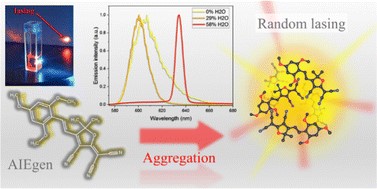The 2,4,6-OMe-TCF dye, exhibiting the aggregation-induced emission (AIE) phenomenon, is investigated according to the generation of laser light. Light amplification is possible only for concentrated solutions with dye amounts close to the saturation level, indicating that the aggregation process plays an essential role in establishing light enhancement. Moreover, lasing is also achievable for the powdered form of the dye, with the clearly evident presence of nano- and micro-crystals; however, in this case, the spectral position of a gain profile is considerably red-shifted. The aggregation caused by a non-solvent addition to a dye solution can increase the average random lasing (RL) emission intensity even by a factor of 170 for the band assigned to aggregates. The dye can serve as a very versatile lasing material; it could be used in the form of a liquid solution as well as a dopant for polymeric matrices. It can be easily processed from solutions; therefore, it perfectly matches the requirements of novel types of soft and elastic materials for printed optoelectronics. Finally, the molecular disorder present in polymeric systems involving the existence of the dye in molecular, aggregated, and crystalline forms can result in the generation of two-photon excited laser emission. We believe that the synthesis of molecular systems exhibiting increased emission quantum yields both in aggregated and crystalline forms may become a common strategy to obtain efficient, multiphoton-excited organic laser materials.
One- and two-photon lasing from a TCF-based AIE dye

